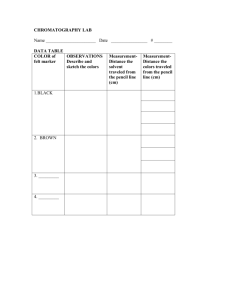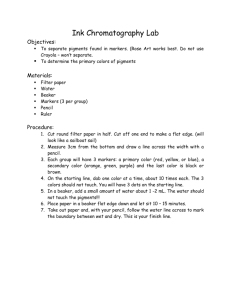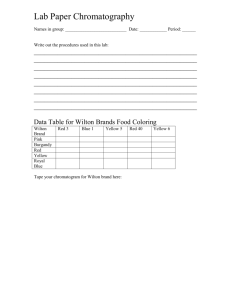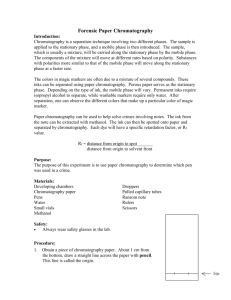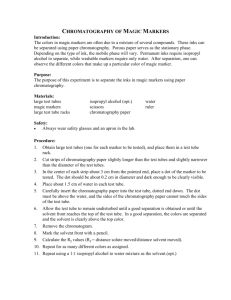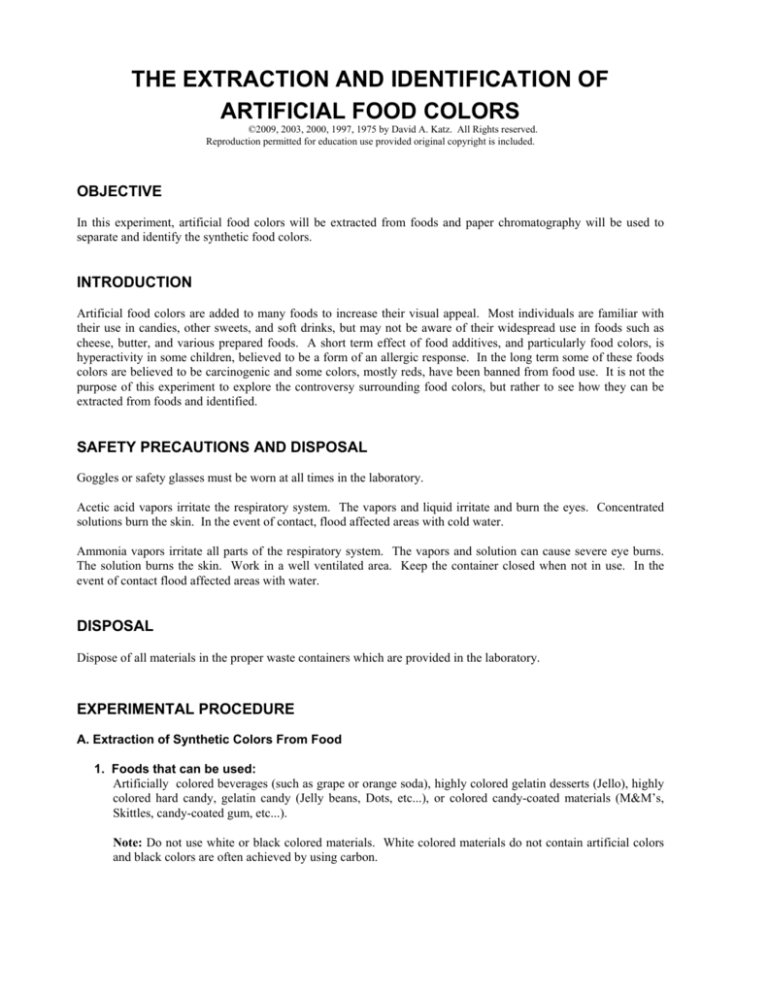
THE EXTRACTION AND IDENTIFICATION OF
ARTIFICIAL FOOD COLORS
©2009, 2003, 2000, 1997, 1975 by David A. Katz. All Rights reserved.
Reproduction permitted for education use provided original copyright is included.
OBJECTIVE
In this experiment, artificial food colors will be extracted from foods and paper chromatography will be used to
separate and identify the synthetic food colors.
INTRODUCTION
Artificial food colors are added to many foods to increase their visual appeal. Most individuals are familiar with
their use in candies, other sweets, and soft drinks, but may not be aware of their widespread use in foods such as
cheese, butter, and various prepared foods. A short term effect of food additives, and particularly food colors, is
hyperactivity in some children, believed to be a form of an allergic response. In the long term some of these foods
colors are believed to be carcinogenic and some colors, mostly reds, have been banned from food use. It is not the
purpose of this experiment to explore the controversy surrounding food colors, but rather to see how they can be
extracted from foods and identified.
SAFETY PRECAUTIONS AND DISPOSAL
Goggles or safety glasses must be worn at all times in the laboratory.
Acetic acid vapors irritate the respiratory system. The vapors and liquid irritate and burn the eyes. Concentrated
solutions burn the skin. In the event of contact, flood affected areas with cold water.
Ammonia vapors irritate all parts of the respiratory system. The vapors and solution can cause severe eye burns.
The solution burns the skin. Work in a well ventilated area. Keep the container closed when not in use. In the
event of contact flood affected areas with water.
DISPOSAL
Dispose of all materials in the proper waste containers which are provided in the laboratory.
EXPERIMENTAL PROCEDURE
A. Extraction of Synthetic Colors From Food
1. Foods that can be used:
Artificially colored beverages (such as grape or orange soda), highly colored gelatin desserts (Jello), highly
colored hard candy, gelatin candy (Jelly beans, Dots, etc...), or colored candy-coated materials (M&M’s,
Skittles, candy-coated gum, etc...).
Note: Do not use white or black colored materials. White colored materials do not contain artificial colors
and black colors are often achieved by using carbon.
2. Apparatus needed:
10 mL graduated cylinder
3 test tubes, 16 x 150 mm
100 mL graduated cylinder
400 or 600 mL beaker
20 or 50 mL beaker
Glass stirring rod
rule, graduated in mm
Wool yarn
3. Reagents needed: (all solutions prepared by mass)
Vinegar, 5% acetic acid solution, HC2H3O2
concentrated ammonia, NH3
4. Procedure:
Use 3 or 4 pieces of candy-coated gum or 6 pieces of M & M’s, Skittles, or other similar coated candy.
Make a water bath by filling a 400-mL beaker with approximately 150 mL water and placing it on a hot plate
in the fume hood. Set the hot plate at medium and heat the water to boiling. You will be using this water
bath throughout the first part of this experiment. Maintain the water at a slow boil, adding additional water
to the beaker to maintain an approximate volume of 150 mL.
Place 6 pieces of candy, all the same color and the same brand, into a test tube. Add enough vinegar to just
cover the candy.
Place the test tube in the water bath and heat it until the colored coating has just dissolved. (Note: heat the
candy long enough to dissolve the color off of the candy coating, trying to dissolve as little of the white candy coating as possible.)
Remove the test tube from the water bath and carefully pour the colored liquid into a second, clean test tube
leaving the solid candy pieces behind. This solution contains the food dyes, some sugar, some emulsifier,
and the vinegar. The solids left from the candy, in the first test tube, can be discarded.
Measure 15 cm of wool yarn and add it to the test tube with the dye solution. Add an additional 3 mL of
vinegar to the test tube.
Place the test tube into the water bath and heat the solution for about 5 minutes, stirring occasionally.
After heating, remove the yarn from the test tube. Rinse it with a little deionized water. The yarn should be
colored from the food dye.
Place the yarn into a clean test tube and add 1 mL of concentrated ammonia solution. Use the stirring rod to
make sure the yarn is submerged in the ammonia. If necessary, add up to an additional 1 mL of ammonia
solution. (Use as little of the ammonia solution as possible.) Heat the test tube in the water bath for about 5
minutes, stirring occasionally.
Remove the test tube from the water bath and allow it to cool. Save this for Part B of the experiment.
B. Chromatographic Separation of the Unknown Color Mixture
1. Reagents needed:
1% sodium chloride solution, NaCl (by mass)
Food color standard solutions: 0.1% solutions of current, permitted, F D & C colors (currently, the approved
FD&C food colors are Red #3, Red #4, Red #40, Blue #1, Blue #2, Yellow #5, and Yellow #6)
2. Apparatus needed:
Chromatography paper (Whatman No. 1 or equivalent), 10 cm x 20 cm
Capillary tubes (open both ends)
600 mL beaker
20 mL beaker or small evaporating dish
Plastic wrap (Saran Wrap or similar) or watch glass to cover beaker
Stapler with staples
3. Procedure:
Obtain a sheet of chromatography paper. Draw a light pencil line across the paper about 1.0 cm from the
bottom of the sheet.
Pour the colored liquid, from the test tube in Part A of this experiment, into a small beaker or evaporating
dish. Using a capillary tube, apply a small spot of the unknown color mixture (obtained in Part A of this
experiment) on the pencil line near the center of the paper. (The color spot should not exceed about 0.4 cm in
diameter.) Mark the paper, in pencil at the top, above the spot with an X to signify the unknown color
mixture (see Figure 2). If the spot seems to be too small or too light in color, you can make it darker by
applying a second spot of color directly on top of the dry first spot. (It is necessary to allow the spot to dry
between applications of color in order to keep it small in size.) If the spot is still seems to be too light in
color, additional spots can be applied on top of the dry color spot.
Spot the paper with each of the available F D & C colors allowing about 2.0 cm minimum distance between
each different spot. Using a pencil, note the identity of each color at the top of the paper above each spot.
Add 1% NaCl solution to a clean 600 mL beaker to a depth of about 0.5 cm (this will require approximately
25 mL of solution). Bend the spotted chromatography paper into a cylindrical shape, butt the ends together
(do not overlap the ends) and staple them. Place the chromatography paper into the beaker making sure that
the spots of dye are not below the solvent level and that the paper is not touching the sides of the beaker.
Cover the beaker with a piece of plastic wrap or with a watch glass. (See Figure 3)
Figure 2. Chromatography paper showing pencil line, spots of color, and identification information
Figure 3. Chromatography paper in the
600-mL beaker developing chamber.
Allow the solvent to move up the paper to within 1 cm of the top (this will take anywhere from 15 to 35
minutes). Remove the paper from the beaker, open it flat, and, using a pencil, mark the solvent front (the
level reached by the solvent). Lay the chromatography paper on a paper towel to dry.
Outline each spot on the chromatography paper in pencil. Measure and record the average distance from the
origin to the solvent front. Measure and record the distance each spot moved from the origin. (See Figure 4)
Determine the Rf values for each spot in the unknown mixture and for each of the F D & C colors that you
used. The Rf values for the components in the unknown mixture will be the same for the same component in
the F D & C known colors. By matching both the color and the Rf value of each of the spots, you can
determine the identity of the colors you extracted from the food.
Save the chromatogram to hand in with your laboratory report.
CLEAN UP
Clean up all the glassware with soapy water. Use a brush to help remove traces of organic materials from the
glass surfaces. Rinse well with water.
Figure 4. Chromatography paper showing how spots may have moved with solvent line and
measurements of distances spots and solvent moved from original pencil line.
Calculations
The Rf value for a spot is calculated using the formula:
Rf
distance spot moved in cm
average distance to solvent line (from origin) in cm
The Rf value will be a decimal fraction
References
“Identifying Synthetic Colors in Food”, Chemistry, 42 (11), 27-8, Dec., 1969
Graichen, Charles, “Quantitative Determination of F D & C Colors in Foods”, Division of Colors and
Cosmetic Tech., Food and Drug Administration, Washington, D.C.
“Candy Chromatography”, from Suchocki, John, and Gibson, Donna, Conceptual Chemistry Laboratory
Manual, Benjamin Cummings, 2001.
THE EXTRACTION AND IDENTIFICATION OF
ARTIFICIAL FOOD COLORS
Name________________________________________
Course/Section ____________________________
Partner’s Name (If applicable) _________________________________________
Date __________________
DATA AND RESULTS
Foodstuff used (include brand name): ___________________________________
Color(s) of original food: _____________________________________________
Color of NH3 extract (liquid, at the end of procedure, Part A): ________________
Average distance traveled by solvent from the pencil line: ________________ cm
Distance traveled, from the pencil line, by spots of known F D & C colors:
F D & C color
Distance traveled
Rf value of spot
____________________
___________________cm
____________________
____________________
___________________cm
____________________
____________________
___________________cm
____________________
____________________
___________________cm
____________________
____________________
___________________cm
____________________
____________________
___________________cm
____________________
____________________
___________________cm
____________________
Distance traveled, from the pencil line, by spot(s) (i.e., colors) in unknown:
Color of the spot
Distance traveled
Rf value of spot
____________________
___________________cm
____________________
____________________
___________________cm
____________________
____________________
___________________cm
____________________
____________________
___________________cm
____________________
____________________
___________________cm
____________________
Identity
of
color(s)
in
___________________________________________________________________
unknown:
____________________________________________________________________________________________
Show a sample calculation for an Rf value for one of the colors above:
QUESTIONS
1.
Why is it important to keep the size of the color/cation spots small when spotting the chromatography paper?
2. Since the colors move at different rates up the chromatography, do you think that this rate of migration could be
used as a chemical “fingerprint” for color identification? (explain your answer)
3. Of the possible factors affecting the chromatographic separation of mixtures, which single factor would most
probably be responsible if you obtained different Rf values on the same sample when it was tested at different
times?
4.
Why is it useful to record the initial color of the food color mixture?
5.
What changes in the procedure would be necessary if the original food used was only lightly colored?
6. If you were to find a color in a food that did not appear to be one of the F D & C approved colors, what action
would you take?

